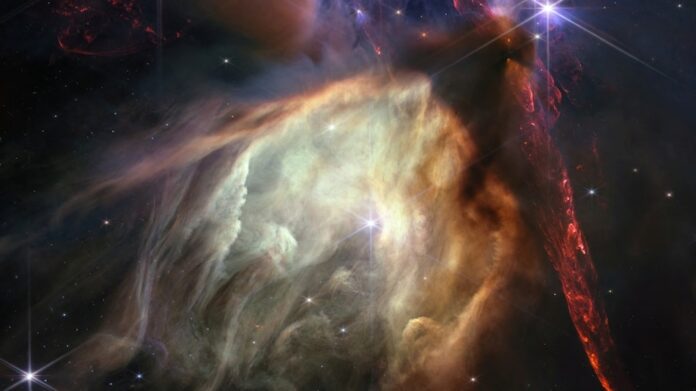NASA released a captivating image captured by the James Webb Space Telescope, showcasing the Rho Ophiuchi cloud complex, which happens to be the nearest region to Earth where stars are forming. This significant milestone coincided with the one-year anniversary of the telescope’s initial scientific findings being unveiled.
Launched in 2021, the Webb telescope has made remarkable contributions to our understanding of the early universe while stunning us with breathtaking glimpses of the cosmos. The recently shared image of Rho Ophiuchi exemplifies this, presenting a nebula—a colossal expanse of interstellar gas and dust—located approximately 390 light years away in our very own Milky Way galaxy. To put this distance into perspective, a light year is equivalent to the staggering span that light covers in a year, amounting to about 5.9 trillion miles (9.5 trillion km).
Despite its proximity, Rho Ophiuchi is incredibly young, only existing for a mere million years in the grand cosmic scheme. Astronomer and former Webb project scientist, Klaus Pontoppidan, now a research scientist at NASA’s Jet Propulsion Laboratory, remarked on the significance of the image, stating,
“Here, we see how new suns are forming, along with planet-forming disks appearing as small dark silhouettes. These are very similar to what we think the solar system looked like more than 4.5 billion years ago.”
The image allows us to witness the birth of stars and planetary systems, as they emerge from their dusty cocoons in spectacular, violent outbursts, illustrated by the striking red jets piercing through the surrounding cloud like a boat cutting through water. The core of Rho Ophiuchi remains concealed, hidden by copious amounts of dust, rendering it invisible to telescopes operating in visible light, such as the Hubble telescope. However, the James Webb Space Telescope triumphs over this obstacle, penetrating the veil of dust and unveiling the nascent stars within, granting us a glimpse into the earliest stages of every star’s existence.
The image, captured between March and April of this year, showcases the impact of the material ejected by young stars on the surrounding gas and dust. It vividly illuminates molecular hydrogen, emphasizing how the stellar winds from one star have sculpted a luminous cave in space.
Pontoppidan expressed his surprise at the size and intricacy of the jets and outflows, stating, “You see an almost impressionistic nebula crowned by three bright young stars on the top.” Since its commencement, the Webb telescope has not only discovered the existence of galaxies and black holes from the earliest epochs of the universe, but it has also observed well-established, yet remarkably compact galaxies teeming with stars that formed within a few hundred million years after the Big Bang, which marked the birth of the universe approximately 13.8 billion years ago—much earlier than previously believed possible.
“Webb has undoubtedly touched nearly every aspect of astrophysics in just one year. It has made notable discoveries, including new galaxies and black holes in the early universe, and provided fresh insights into exoplanetary atmospheres. The Rho Ophiuchi image exemplifies how Webb offers us an unprecedented window into the captivating process of star and planet formation,” added Pontoppidan.
Unlike its predecessor, the Hubble Space Telescope, the James Webb Space Telescope was specifically designed to be highly sensitive, primarily observing the universe in the infrared spectrum. While Hubble predominantly explored the cosmos using optical and ultraviolet wavelengths, Webb has the capability to gaze into even greater distances, peering back further in time than ever before.
NASA Administrator Bill Nelson celebrated the monumental achievements of the James Webb Space Telescope, noting,
“In just one year, the James Webb Space Telescope has transformed humanity’s view of the cosmos, peering into dust clouds and seeing light from faraway corners of the universe for the very first time. Every new image is a new discovery, empowering scientists around the globe to ask and answer questions they once could never dream of.”







